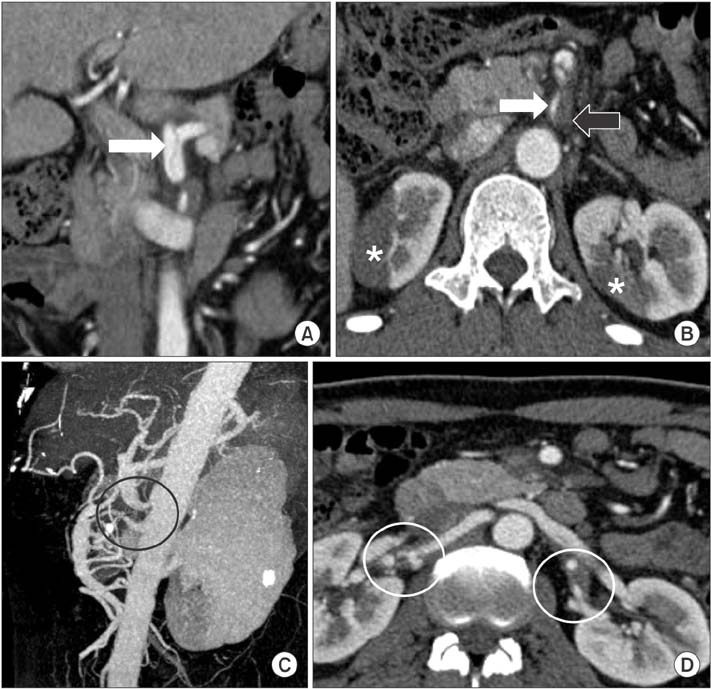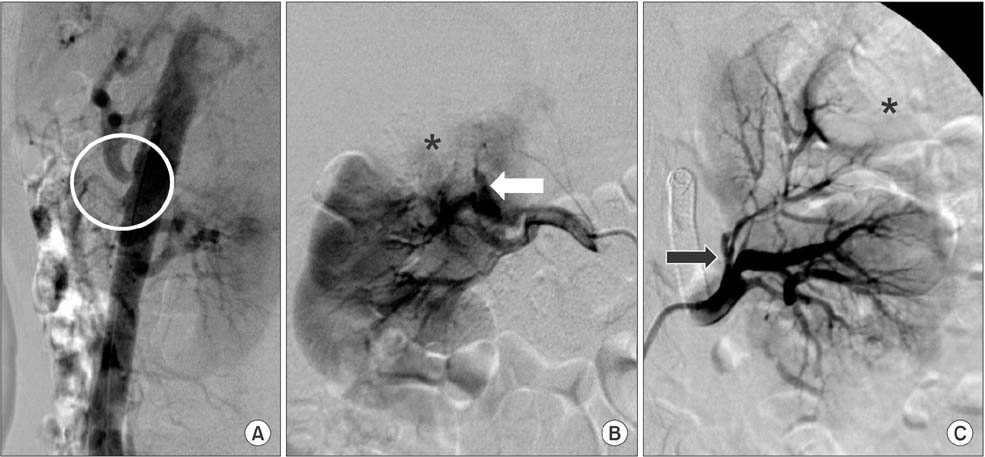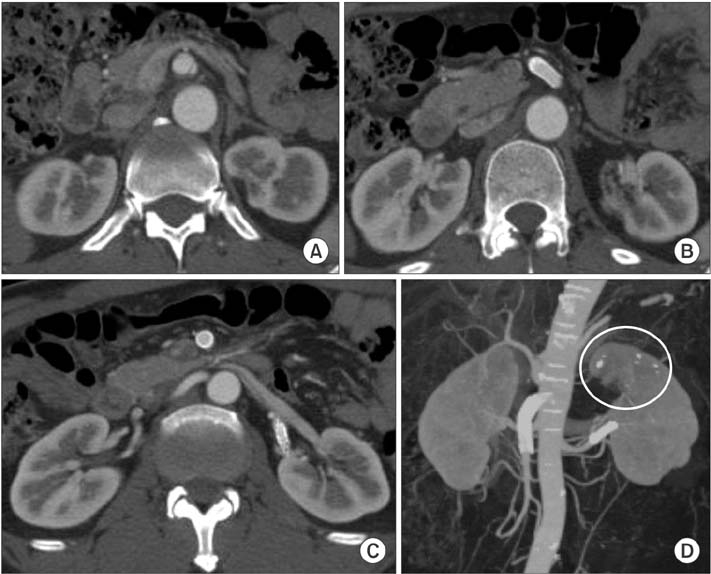Ann Surg Treat Res.
2017 Apr;92(4):225-229. 10.4174/astr.2017.92.4.225.
Spontaneous dissections of multiple visceral arteries: an extremely rare case
- Affiliations
-
- 1Endovascular Training Center, Inha University Hospital, Incheon, Korea.
- 2Department of Radiology, Inha University School of Medicine, Incheon, Korea. radjeon@inha.ac.kr
- 3Department of Vascular Surgery, Inha University School of Medicine, Incheon, Korea.
- KMID: 2374689
- DOI: http://doi.org/10.4174/astr.2017.92.4.225
Abstract
- Spontaneous dissections of visceral arteries without aortic involvement are very rare. The etiologies of these entities are unclear and their clinical managements remain controversial. We report a case of spontaneous multiple dissections affecting 4 visceral arteries including the superior mesenteric artery, the celiac artery and the bilateral renal arteries. The patient was managed conservatively and endovascularly. The clinical manifestation markedly improved and laboratory tests returned to normal limits within 1 week. The regular follow-up suggested a good clinical and radiological outcome until 84 months.
MeSH Terms
Figure
Cited by 1 articles
-
Antithrombotic therapy has no beneficial effect in conservative treatment of spontaneous isolated superior mesenteric arterial dissection
Young Sup Yoo, Soo Jin Na Choi, Ho Kyun Lee
Ann Surg Treat Res. 2021;100(3):166-174. doi: 10.4174/astr.2021.100.3.166.
Reference
-
1. Zeina AR, Nachtigal A, Mahamid A, Soimu U, Ashkenazi I, Oster M. Isolated spontaneous dissection of a visceral artery: a rare cause of epigastric pain. Emerg Radiol. 2015; 22:215–220.2. Jung SC, Lee W, Park EA, Jae HJ, Chung JW, Park JH. Spontaneous dissection of the splanchnic arteries: CT findings, treatment, and outcome. AJR Am J Roentgenol. 2013; 200:219–225.3. Katz-Summercorn AC, Borg CM, Harris PL. Spontaneous renal artery dissection complicated by renal infarction: a case report and review of the literature. Int J Surg Case Rep. 2012; 3:257–259.4. Jain A, Tracci MC, Coleman DM, Cherry KJ, Upchurch GR Jr. Renal malperfusion: spontaneous renal artery dissection and with aortic dissection. Semin Vasc Surg. 2013; 26:178–188.5. Takayama T, Miyata T, Shirakawa M, Nagawa H. Isolated spontaneous dissection of the splanchnic arteries. J Vasc Surg. 2008; 48:329–333.6. Takach TJ, Madjarov JM, Holleman JH, Robicsek F, Roush TS. Spontaneous splanchnic dissection: application and timing of therapeutic options. J Vasc Surg. 2009; 50:557–563.7. Bonardelli S, Battaglia G, Zanotti C, Cervi E, Guadrini C, Giulini SM. Sequential multiple visceral arteries dissections without aortic involvement. Ann Vasc Surg. 2013; 27:497.e9–497.e13.8. Gobble RM, Brill ER, Rockman CB, Hecht EM, Lamparello PJ, Jacobowitz GR, et al. Endovascular treatment of spontaneous dissections of the superior mesenteric artery. J Vasc Surg. 2009; 50:1326–1332.9. DiMusto PD, Oberdoerster MM, Criado E. Isolated celiac artery dissection. J Vasc Surg. 2015; 61:972–976.10. Takayama Y, Takao M, Inoue T, Yoshimi F, Koyama K, Nagai H. Isolated spontaneous dissection of the celiac artery: report of two cases. Ann Vasc Dis. 2014; 7:64–67.
- Full Text Links
- Actions
-
Cited
- CITED
-
- Close
- Share
- Similar articles
-
- Ischemic Infarctions in Young Men Secondary to Traumatic and Spontaneous Intracranial Arteries Dissection
- Spontaneous Isolated Dissection of the Celiac Artery: a Case Report
- Spontaneous Visceral Artery Hemorrhage in a Patient with Systemic Lupus Erythematosus Combined with Antiphospholipid Syndrome: A Case Report
- A Case of Vascular Ehlers-Danlos Syndrome Presenting with Multiple Cerebral Arterial Dissections
- A Case of Spontaneous Renal Artery and Celiac Artery Dissection in Healthy Man




